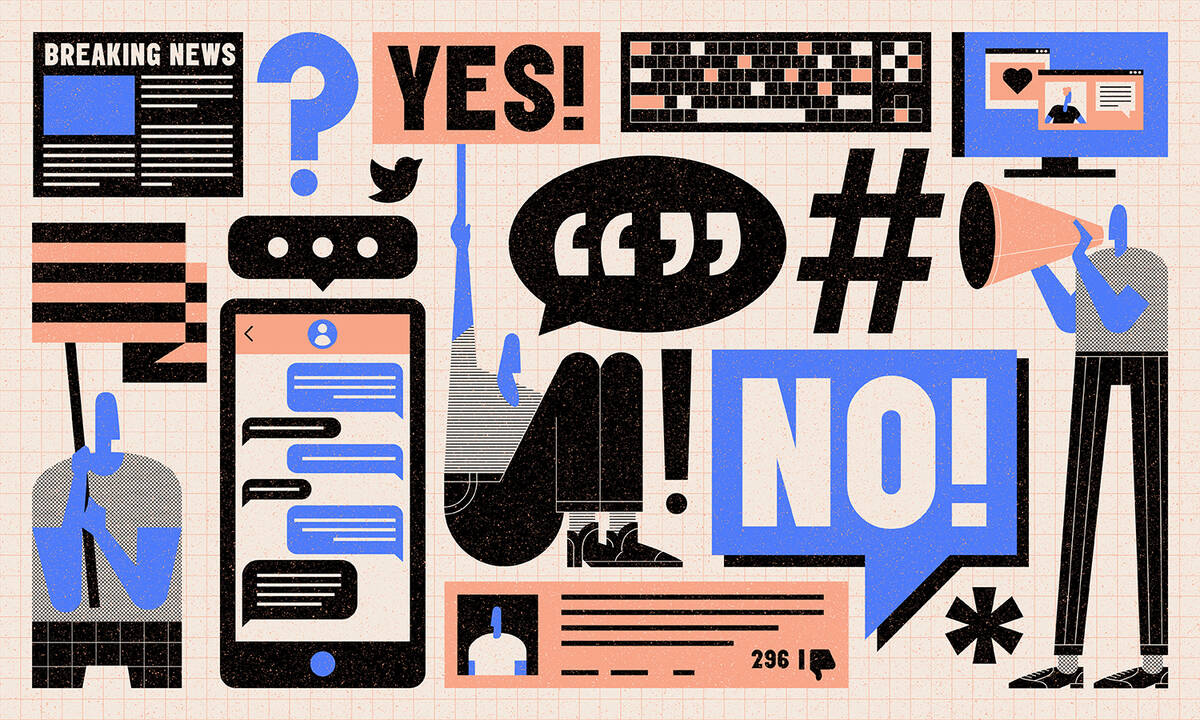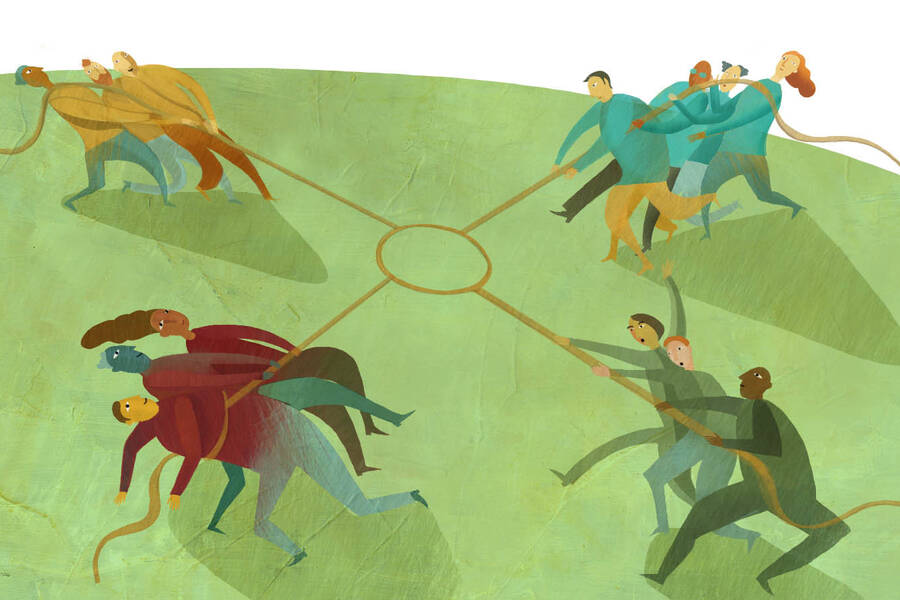In the months since, many political leaders—including President Biden—have spoken of repairing, restoring, and healing the divisions that led to the violence at the Capitol. But what does that look like when every issue feels inescapably polarized?
We decided to ask two Kellogg professors, Brian Uzzi and Cynthia Wang.
Last year, pre-pandemic, we sat down with them for a discussion about the psychology of conflict. And at the time, they were somewhat optimistic, pointing out that conflict can be harnessed to bring about positive change.
A year later, our conversation was more sober. Still, Uzzi and Wang offer ideas for how we can move forward.
This conversation has been edited for length and clarity.
Brian UZZI: Ultimately, the way societies keep a lid on conflict among groups is that their institutions act like a safety valve.
So, for example, the police are an institution that’s essentially intended to lessen potential violence and conflict among people. You don’t have to get involved yourself, you can call the police. Organized religion is also supposed to help us turn the other cheek and reduce conflict.
The last 20 years or so, we’ve seen these institutions all begin to become frayed in one way or another. The recent conflicts we’ve had in the U.S. have helped us to define some of the real problems with these institutions and how they need to be modified and redesigned to bring us back into some kind of balance around conflict.
Cynthia WANG: I do think, unfortunately, everything has hit a boiling point. What happened at the Capitol was a wake-up call. Hopefully, because of this there is more pressure to come up with solutions and understand where there are cracks in the system.
I think we’re at a crossroads with social media also. On Facebook and YouTube and Twitter, so many conspiracy theories are spreading and it’s like the wild, wild west. Anything can be put online.
And I feel there are things that we have to start thinking about that we’ve never faced before, like that a lot of these inflammatory tweets come from people who aren’t actually really there, but are bots. So we need to understand how to deal with robots, which studies show are more likely to spread conspiratorial assertions, such as QAnon or the deep state.
We have to understand that bots are made to provide narratives around conspiracy theories and other things that are going to be inflammatory. What’s been hard, I think, with a lot of the conflict these days is how quickly this inflammatory language and misinformation spreads through these online tools.
UZZI: Group conflict requires that we create group identities to begin with. And those identities come about through conflict. It’s a process: you have to have something typically ascriptive about individuals that allows them to initially see themselves as being in one group versus another. You then need to put out information that reinforces that the ascriptive aspects of someone are really an expression of what makes them different way down deep inside.
It could be intelligence; it could be work ethic; it could be religious beliefs about God. The bots Cynthia mentions are always playing both sides because in order to ratchet up the conflict, you have to have both sides really getting to the point where they see themselves first as different—and then eventually as threats to each other’s existence.
The other thing with conflict is: it often starts to build in rhetoric, but then you often need some kind of physical event to strengthen the boundary between groups. And that physical event is usually violent, which gives each group an opportunity to say, “You see, all those things I told you about those other people are in fact true.”
WANG: We’re at a place where things have gotten very toxic. We have these mega-identities now where we’re drawing the lines on not only demographics, but geography. And these mega-identities make it really, really hard to work with the other side. And even worse, we dramatically misperceive the other side’s negative intentions. We basically think the other side’s evil.
There are parallel universes where each side has their own reality without really understanding the other side at all. So, it is hard to see a silver lining because all of this stuff—the pandemic, the conflicts around racial justice, the elections, the economy—have contributed. On top of it all, we’re socially excluded. The combination of everything has just made it very difficult to come together.
UZZI: There’s an old adage that says: “You can escape reality, but you can’t escape the consequences of reality.” But what happens when you can escape reality and its consequences? For example, once someone, including our highest leaders, can say, “Oh, the attack on the Capitol was a hoax,” which is what a Michigan legislator said just weeks after the attack, it signals that we’re moving into a world where you can escape the consequences of reality.
This is how misinformation breaks down safety-value institutions.
When people begin to think that the institutions are breaking down—implying that they can no longer rely on institutions for protection—chaotic violence erupts. That’s what happened at the Capitol. The people attacking genuinely believed that the election was stolen.
So how do you replace that belief? Well, a lot of it could be replaced with leadership. For example, when Trump said, “Hey, leave the Capitol,” people packed up and went home. But until he said that, they were going to stay there—and perhaps become even more violent.
For months Sidney Powell, former attorney to former president Trump, vehemently repeated the “Big Lie” that the election had been stolen on media, to legislators, and before the courts. After being sued for slander and libel, she now claims in court that she knew it was a big lie, but that “no reasonable person would take her voter fraud claims as fact,” so she bears no responsibility for anyone who acted on her lie or whose business was destroyed because of it. She also claims that Rudy Guiliani and Donald Trump are reasonable people, but they believed the “Big Lie.” So where’s the truth?
Leaders destroy credibility in institutions and restore faith in institutions through their actions.
WANG: Yeah, we have a former leader who was basically saying, “Hey, you should not trust the institution.” And that led to a lot of public distrust.
There’s research that suggests that status really matters in the spread of conspiracy theories. Studies find that although high-status people—whether it’s politicians or other high-status individuals—only spread about 20 percent of the misinformation online, they account for approximately 70 percent of the social-media engagement. So these few people can have a huge impact on the information they spread. And when they’re spreading this misinformation, it is treated as truth because people believe these high-status people. And that’s what’s dangerous.
UZZI: Students often ask me: When did leaders really change people’s points of view so quickly? I have one example that helps explain it. In 1939, they released the movie version of Gone with the Wind. The film ends with a curse word being said on film: “Frankly, my dear, I don’t give a damn.” If you then track the use of “damn” in public discourse after that, it totally skyrockets and never stops.
Sometimes it takes one person of status to change everything. And we are in a system right now where people don’t know what to believe. They’re getting so much information. They don’t have frameworks in their head for analyzing it. They’re overloaded. For every piece of information they hear, there’s a counter piece of information. But the mind needs to get rid of all the uncertainty. And the simplest thing to do is to follow that critical mass of the leader.
When we think about group conflict, the quickest way to right the ship is to unite against a common third enemy. In doing so, people begin to see the value in each other, they have to cooperate with each other, and they’re more willing to help somebody else in need. They don’t see it as just losing without gaining. But at the level where we are, it’s hard to see what that might be. COVID could have been one of those things, but it didn’t turn out that way.
WANG: I feel like misinformation is such a big trigger these days, if there’s any way to at least get individuals to discern what’s true from what’s false, that can be a huge step forward. Because I think that’s what has snowballed into the bigger issues that we’ve seen today.
People’s natural default is just to believe what they see if it fits in with their reality rather than to be a little bit more discerning about whether something is accurate or not.
There is a recent article in Psychological Science related to the pandemic that finds that if you can actually just ask people whether, to the best of their knowledge, a news headline is accurate, that simple nudge actually leads to less intention to share misinformation.




